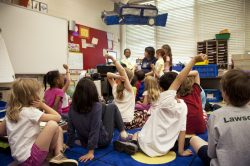
The mission of Arkansas Advocates for Children and Families (AACF) is to ensure that all children and families have the resources and opportunities they need to lead healthy and productive lives and realize their full potential.
We recognize that the health and economic challenges brought about by the COVID-19 pandemic are unprecedented in their scope. Arkansas is attempting to meet these challenges in the face of major logistical, economic, and resource challenges facing our schools, state government, employers, and families.
Arkansas schools are being asked to bear the brunt of these challenges. In the middle of a pandemic that is ravaging the health of our families, friends, and neighbors, Arkansas’s schools are being asked to balance and meet the sometimes competing goals of (1) getting our students physically back in school so they can reap the social, emotional, and cognitive benefits of in-person learning, instruction, and personal interaction; (2) protecting the health and safety of our students, teachers and staff, their families, and others in our communities; and (3) maximizing the ability of our families to work and support their families in an economy that has seen unprecedented job losses.
In addition to the unprecedented challenges facing schools, AACF is deeply concerned about the impact COVID-19 and the state’s policy response on the well-being of at-risk students, including low-income students, students of color, English language learners, and students with special education needs. These students — who already faced major equity gaps in resources, opportunities, and educational outcomes before the pandemic — have lost and will continue to lose further ground in education unless they are made a priority in our state public health and state and local educational responses to the virus. At a minimum this will require major investments to improve the online connectivity for at-risk families in both urban and rural areas, improve the digital literacy of both at-risk students and their parents, and reduce the gap in access to devices. Unless these gaps are met, not all families will have a real and equal choice when it comes to school attendance decisions. This is currently not happening to a sufficient degree.
The Arkansas education system, like virtually every other education system in the country, is ill-equipped to meet these challenges at the current time. State data trends in COVID-19 prevalence, such as the number of positive cases and the percentage of positive tests, yet to show a downward trend for 14 days, indicating that community spread is still not where it needs to be and testing is still not sufficient to reach all infected people. We still have far too many local school districts who are deemed high-risk for the virus. There is also insufficient evidence that most school districts have what they need to meet recommended social distancing guidelines, adequate personal protective equipment (PPE) for all school personnel, adequate engineering support to prevent the airborne spread of the virus, and plans that demonstrate they are logistically prepared to meet the challenges posed by COVID-19 in keeping their students and school personnel safe. There is also insufficient evidence that most school districts have what they need to help reduce equity gaps for our most at-risk students.
In short, Arkansas’s public schools are not yet ready to reopen in a way that can guarantee the safety of students and school personnel and mitigate the equity impacts for at-risk students. With this in mind, AACF proposes the following in regard to the opening of Arkansas’s public schools.
The state should take a pause until mid-September in reopening schools until state data trends in COVID-19 prevalence, such as a downward trend in cases and a downward trend in the percentage of positive tests (assuming sufficient testing). In particular, we are concerned that community spread will reassert itself in the aftermath of the Labor Day holiday.
After the pause, individual school districts should have the flexibility of reopening as long as they meet certain improving health metrics relative to COVID-19 prevalence in their local communities, such as a downward trend in cases and a downward trend in the percentage of positive tests (assuming sufficient testing). While having this flexibility, their decisions have to be data driven.
Before they are allowed to reopen, school districts will have to prove they can meet certain health and safety standards, including: (1) minimum social distancing requirements, which could require smaller cohorts of students and fewer students in school; (2) a mandatory mask policy for K-12 students; (3) adequate PPE for all school personnel; (4) adequate hand sanitizing and cleaning supplies; and (5) classroom and school ventilation system that are sufficient to minimize the airborne spread of COVID-19.
Parents should have the option of choosing an all-virtual or in-person instruction if their district has opted to be open for in-person instruction when the community data trends and when the district can meet the standards listed above.
The state should focus existing resources on closing equity gaps and prioritizing the needs of at-risk groups (low-income, k-5, students of color, kids with disabilities, English language learners) in terms of allocating resources for virtual instruction, making schools safe, and priority for in-school instruction when space is limited to meet social distancing and safety guidelines. To that end, the state of Arkansas and each school district should have a plan demonstrating how it intends to prioritize the needs of at-risk groups and close these equity gaps.
We know that not everyone will agree with these recommendations, nor will they be easy to implement. But we have to do what is right and best for our children and our teachers, not what our political leaders want or what they think will be most politically acceptable. The well-being of our children and our teachers, especially those most at risk of bearing a disproportionate share of the impact of COVID-19, have to be our top priority.
